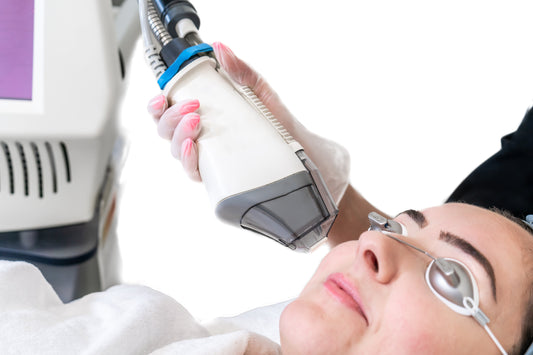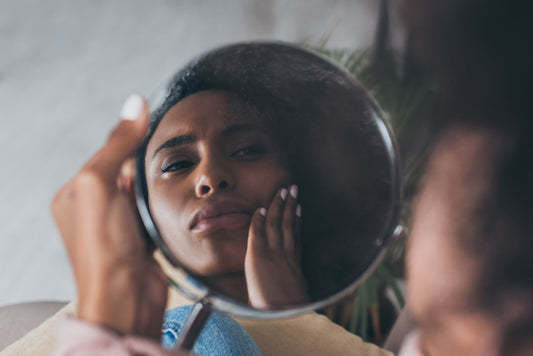Maybe you’ve noticed hairs on your pillow or in the drain after a shower. If so, you’re probably worried it's a sign of male pattern baldness. You might be right.
Male pattern hair loss, or androgenetic alopecia, affects 80 percent of American men by the time they are 501 and usually starts in his 30s. Don’t fret. Understanding androgenetic alopecia is the key to determining how and if you treat it.
Understanding Male Pattern Baldness
Male pattern baldness is just one type of hair loss and they are not treated the same way.
To determine what is causing your hair loss, your doctor considers:5
- Medical history
- Age hair loss started
- How long it has lasted
- Severity and distribution
- Other symptoms, like a burning, itching, or tender scalp.
Hair loss can be due to conditions such as infections, scalp psoriasis, alopecia areata which causes patchy hair loss on your scalp or beard, or traction alopecia which can be a result of tight hairstyles.2
Male pattern hair loss doesn’t have to be treated, but there are several ways to treat, disguise, or live happily with it.
Symptoms of Male Pattern Baldness
How do you know if you have male pattern baldness?
Early signs of hair loss include thinning hair, a bald spot, a receding hairline, a widening part, or a thinner ponytail.2
Changes are gradual.There are seven stages of male pattern baldness:3
- Little or no hair loss.
- Slight hair loss at your temples.
- Hairline recession deepens, usually in an “M” pattern or “U” pattern.
- Increased hairline recession and hair loss on the top of your head..
- Hairline recession meets top hair loss.
- Thinning or hair loss between temples and crown of your head.
- No hair on top with a thin band of hair around the sides of your head.
You should see your doctor if you notice hair loss that doesn’t follow the stages including:1
- Rapid, widespread shedding, patches of hair loss, or hair breakage.
- Scalp itching, skin irritation, redness, scaling, or pain.
- Sudden hair loss after taking a new medication.
Common Causes of Male Pattern Baldness
Your first question may be “Why me?”
Researchers have asked that for years. Several factors affect what causes male pattern baldness.
- Race: You are more likely to have androgenetic alopecia if you are of European or Afro-Caribbean descent.3
- Family History: If your father, grandfather, brother, or mother’s father is bald, you’re more likely to be as well.3
- Hormones: Research shows male pattern baldness is caused by a sensitivity to dihydrotestosterone (DHT), a hormone that plays a key role in sexual development. High levels of DHT can shrink hair follicles and shorten the hair growth cycle.3
- Genetics: One of the 63 genes identified as playing a role in hair loss4 tells your body how to make sex hormones and that gene’s sensitivity to DHT helps determine male pattern baldness.3
Myths and Misconceptions About Hair Loss
We’ve all heard them - the theories about baldness - but should you believe any of them? Maybe. Looking deeper reveals some buried truths.
- Hair loss is passed down from your mother. As mentioned above, both your parents’ histories with hair loss play a role in your risk of hair loss, but if your father is bald, you are twice as likely to follow suit.3
- Male pattern baldness only affects older people. Fifty-three percent of men in their 40s already have moderate to severe hair loss.6 Some people start losing their hair in their teens.
- Wearing hats suffocates your hair. This is false, however, if you already have hair loss, you may see strands of hair in your hat.7
- Stress makes your hair fall out. Some people see sudden hair shedding in the months after a physically or emotionally stressful experience, like giving birth, dramatic weight loss, or going through a divorce. The hair typically regrows with no treatment.8
- Sun exposure promotes hair loss. UV rays can dry out your hair, weakening the hair shaft and causing breakage. This will stop once your hair is healthier.9
- Smoking is bad for your hair. Add to the many reasons to stop smoking the fact that it causes decreased circulation, which can mean a loss of blood flow to your hair follicle cells and scalp inflammation. This reverses when you stop smoking.7
- All hair loss is permanent. Because androgenetic alopecia doesn’t scar, hair regrowth for men is possible, however, that doesn’t guarantee that existing treatments will work for everyone.10
Different Treatments for Hair Loss
There are two parts to successfully treating male pattern baldness. First, start treatment as early as you can. Second, make sure your scalp and hair are healthy.
There are several hair loss treatments for men. Let’s start with FDA-approved treatments to slow hair loss and foster regrowth.
- Minoxidil is a topical over-the-counter lotion or foam applied directly to the scalp to stimulate hair follicles. It may cause itchy, dry scalp.11
- Finasteride is a prescription oral medication that typically works better than minoxidil, but can have serious side effects like impotence and depression. Like minoxidil, if you stop taking it, hair loss will resume.11
- Platelet-rich plasma, performed in your doctor’s office, is filtered from your blood and injected into the scalp to stimulate hair growth. It requires several sessions.11
- Low-laser light therapy is available over the counter and can stimulate hair follicles, increase blood flow, and promote cell vitality.11
- Hair transplants remove plugs of hair from areas where it is growing and puts them in balding areas. It can take a year to see full results and may require touch up sessions.3
A few treatments are FDA approved for other conditions, but are often prescribed off-label to treat hair loss.
- Dutasteride is an oral prescription prostate medication that works similarly to finasteride. Early studies show that it is three times more effective.12
- Latanoprost is a topical prescription glaucoma medication that increases hair density.11
If you are concerned about side effects, cost or other issues from these treatments, topical Foundation Skincare Hair Serum can reduce hair loss and stimulate hair stem cells without irritating your scalp and is safe for long-term use.
Deficiencies in vitamins essential for hair growth, such as zinc, biotin, or protein, can accelerate hair loss.13 Foundation Skincare Untangled Hair Growth Supplement ensures you are getting what you need for fuller, lusher hair. It also works very well in combination with the Hair Serum from the outside and the very strategically and scientifically formulated vitamins and minerals from the inside.
A healthy lifestyle promotes healthy hair and scalp. Experts suggest keeping hair clean and using conditioner. Some studies show that ketoconazole, an antifungal found in dandruff shampoos, can reduce scalp inflammation in men with hair loss.11
Non-medication ways to disguise hair loss include hairpieces, wigs, weaves, and hair styles. While effective, they may be expensive and limit your activities, such as swimming or playing sports.
Coping with Hair Loss
Male hair loss can be trivialized because it is common and not life threatening.14
Studies show, however, that men with hair loss have a high prevalence of depression and anxiety. They may feel like hair loss makes them look old or unattractive, lowering self-esteem and increasing feelings of social rejection.15
Men are often embarrassed to seek early treatment. Research suggests that more education about hair loss and treatment options can help.16
If you are struggling emotionally with your hair loss, reach out to your doctor or consider counseling. There are several online resources, including chat rooms and Youtube channels, to support you in your hair loss journey.17
A bald positivity movement encourages men to embrace hair loss by shaving their heads. Many men have found it freeing - saying hair loss no longer dominates their thoughts.17
Don’t hide from hair loss. It is a reality for most men and doesn’t have to change your life. Whether you decide to try treatments to slow the progress or to make being bald a sexy statement, learn about your options so that you can feel confident about how you look and feel.
References:
-
https://www.medicalnewstoday.com/articles/68077
-
https://www.aad.org/public/diseases/hair-loss/insider/begin
-
https://my.clevelandclinic.org/health/diseases/24515-male-pattern-baldness-androgenic-alopecia
-
https://pubmed.ncbi.nlm.nih.gov/28272467/
-
https://www.ccjm.org/content/88/3/173
-
https://www.ncbi.nlm.nih.gov/books/NBK278957/
-
https://www.mcgill.ca/oss/article/health-general-science/will-wearing-hat-make-me-go-bald
-
https://www.ncbi.nlm.nih.gov/books/NBK430848/
-
https://www.henryford.com/blog/2021/11/7-common-hair-loss-myths
-
https://www.aad.org/public/diseases/hair-loss/treatment/diagnosis-treat
-
https://www.ccjm.org/content/88/3/173
-
https://www.ncbi.nlm.nih.gov/books/NBK430924/
-
https://www.health.harvard.edu/diseases-and-conditions/vitamins-minerals-and-hair-loss-is-there-a-connection
-
https://www.ncbi.nlm.nih.gov/books/NBK278957/
-
https://www.ncbi.nlm.nih.gov/pmc/articles/PMC7037739/
-
https://www.ncbi.nlm.nih.gov/books/NBK430924/
-
https://www.menshealth.com/uk/style/grooming/a37403636/male-pattern-baldness-coping/





